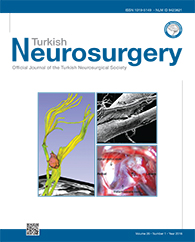2The Chinese PLA General Hospital, Department of Geriatric Neurology, Beijing, China DOI : 10.5137/1019-5149.JTN.11356-14.2 AIM: To better understand the clinical characteristics of central neurocytoma (CN), as well as to assess the optimum therapeutic schedule.
MATERIAL and METHODS: This was a retrospective study of 32 patients with CN who visited our department between January 2008 and January 2013. We analyzed the clinical and radiological presentations, tumor characteristics, surgical strategies, and the prognosis.
RESULTS: We performed operation guided by combined intraoperative magnetic resonance imaging (iMRI) and neuronavigation in 25 patients. The iMRI detected residual tumor in 9 cases, and further resection was performed in 5 cases. Total and nearly total tumor resection was achieved in 29 cases (91%). There was no significant difference between transcortical and transcallosal approaches in complications. Two cases (6%) with recurrence received respectively repeat salvage surgery and radiosurgery at 46 and 50 months after surgery. Thirty patients (94%) had excellent functional outcome (Karnofsky Performance Score ≥80) and 28 patients (88%) resumed their occupations.
CONCLUSION: Our study demonstrates radical surgery with excellent neurological outcomes is the primary treatment of CN. The techniques of resection guided by combined iMRI and neuronavigation seems to enable a higher complete resection rate and reduce the morbidity rate during surgery. We suggest careful clinical observation after initial surgery, and repeat salvage surgery or radiosurgery for recurrent CN.
Keywords : Central neurocytoma, Neuronavigation, Surgery, Transventricular approach, Radiosurgery




